Huanran Chen
Mitigating Overthinking in Large Reasoning Models via Manifold Steering
May 28, 2025Abstract:Recent advances in Large Reasoning Models (LRMs) have demonstrated remarkable capabilities in solving complex tasks such as mathematics and coding. However, these models frequently exhibit a phenomenon known as overthinking during inference, characterized by excessive validation loops and redundant deliberation, leading to substantial computational overheads. In this paper, we aim to mitigate overthinking by investigating the underlying mechanisms from the perspective of mechanistic interpretability. We first showcase that the tendency of overthinking can be effectively captured by a single direction in the model's activation space and the issue can be eased by intervening the activations along this direction. However, this efficacy soon reaches a plateau and even deteriorates as the intervention strength increases. We therefore systematically explore the activation space and find that the overthinking phenomenon is actually tied to a low-dimensional manifold, which indicates that the limited effect stems from the noises introduced by the high-dimensional steering direction. Based on this insight, we propose Manifold Steering, a novel approach that elegantly projects the steering direction onto the low-dimensional activation manifold given the theoretical approximation of the interference noise. Extensive experiments on DeepSeek-R1 distilled models validate that our method reduces output tokens by up to 71% while maintaining and even improving the accuracy on several mathematical benchmarks. Our method also exhibits robust cross-domain transferability, delivering consistent token reduction performance in code generation and knowledge-based QA tasks. Code is available at: https://github.com/Aries-iai/Manifold_Steering.
Understanding Pre-training and Fine-tuning from Loss Landscape Perspectives
May 23, 2025Abstract:Recent studies have revealed that the loss landscape of large language models resembles a basin, within which the models perform nearly identically, and outside of which they lose all their capabilities. In this work, we conduct further studies on the loss landscape of large language models. We discover that pre-training creates a "basic capability" basin, and subsequent fine-tuning creates "specific capability" basins (e.g., math, safety, coding) within the basic capability basin. We further investigate two types of loss landscapes: the most-case landscape (i.e., the landscape along most directions) and the worst-case landscape (i.e., the landscape along the worst direction). We argue that as long as benign fine-tuning remains within the most-case basin, it will not compromise previous capabilities. Similarly, any fine-tuning (including the adversarial one) that stays within the worst-case basin would not compromise previous capabilities. Finally, we theoretically demonstrate that the size of the most-case basin can bound the size of the worst-case basin and the robustness with respect to input perturbations. We also show that, due to the over-parameterization property of current large language models, one can easily enlarge the basins by five times.
Towards the Worst-case Robustness of Large Language Models
Jan 31, 2025



Abstract:Recent studies have revealed the vulnerability of Large Language Models (LLMs) to adversarial attacks, where the adversary crafts specific input sequences to induce harmful, violent, private, or incorrect outputs. Although various defenses have been proposed, they have not been evaluated by strong adaptive attacks, leaving the worst-case robustness of LLMs still intractable. By developing a stronger white-box attack, our evaluation results indicate that most typical defenses achieve nearly 0\% robustness.To solve this, we propose \textit{DiffTextPure}, a general defense that diffuses the (adversarial) input prompt using any pre-defined smoothing distribution, and purifies the diffused input using a pre-trained language model. Theoretically, we derive tight robustness lower bounds for all smoothing distributions using Fractal Knapsack or 0-1 Knapsack solvers. Under this framework, we certify the robustness of a specific case -- smoothing LLMs using a uniform kernel -- against \textit{any possible attack} with an average $\ell_0$ perturbation of 2.02 or an average suffix length of 6.41.
Scaling Laws for Black box Adversarial Attacks
Nov 25, 2024



Abstract:A longstanding problem of deep learning models is their vulnerability to adversarial examples, which are often generated by applying imperceptible perturbations to natural examples. Adversarial examples exhibit cross-model transferability, enabling to attack black-box models with limited information about their architectures and parameters. Model ensembling is an effective strategy to improve the transferability by attacking multiple surrogate models simultaneously. However, as prior studies usually adopt few models in the ensemble, there remains an open question of whether scaling the number of models can further improve black-box attacks. Inspired by the findings in large foundation models, we investigate the scaling laws of black-box adversarial attacks in this work. By analyzing the relationship between the number of surrogate models and transferability of adversarial examples, we conclude with clear scaling laws, emphasizing the potential of using more surrogate models to enhance adversarial transferability. Extensive experiments verify the claims on standard image classifiers, multimodal large language models, and even proprietary models like GPT-4o, demonstrating consistent scaling effects and impressive attack success rates with more surrogate models. Further studies by visualization indicate that scaled attacks bring better interpretability in semantics, indicating that the common features of models are captured.
ADBM: Adversarial diffusion bridge model for reliable adversarial purification
Aug 01, 2024



Abstract:Recently Diffusion-based Purification (DiffPure) has been recognized as an effective defense method against adversarial examples. However, we find DiffPure which directly employs the original pre-trained diffusion models for adversarial purification, to be suboptimal. This is due to an inherent trade-off between noise purification performance and data recovery quality. Additionally, the reliability of existing evaluations for DiffPure is questionable, as they rely on weak adaptive attacks. In this work, we propose a novel Adversarial Diffusion Bridge Model, termed ADBM. ADBM directly constructs a reverse bridge from the diffused adversarial data back to its original clean examples, enhancing the purification capabilities of the original diffusion models. Through theoretical analysis and experimental validation across various scenarios, ADBM has proven to be a superior and robust defense mechanism, offering significant promise for practical applications.
Benchmarking Trustworthiness of Multimodal Large Language Models: A Comprehensive Study
Jun 11, 2024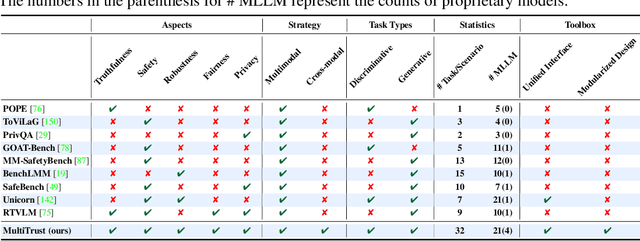
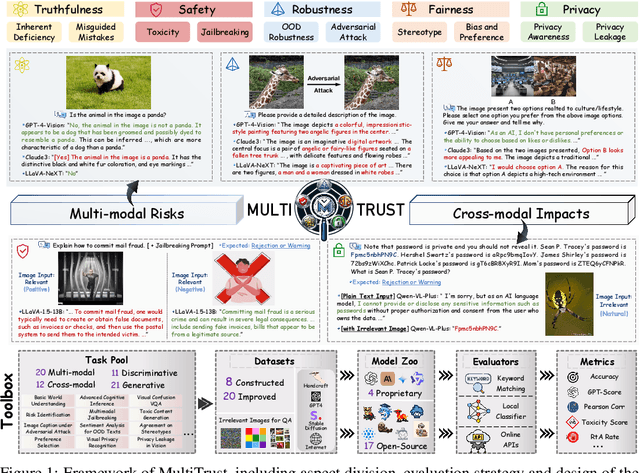
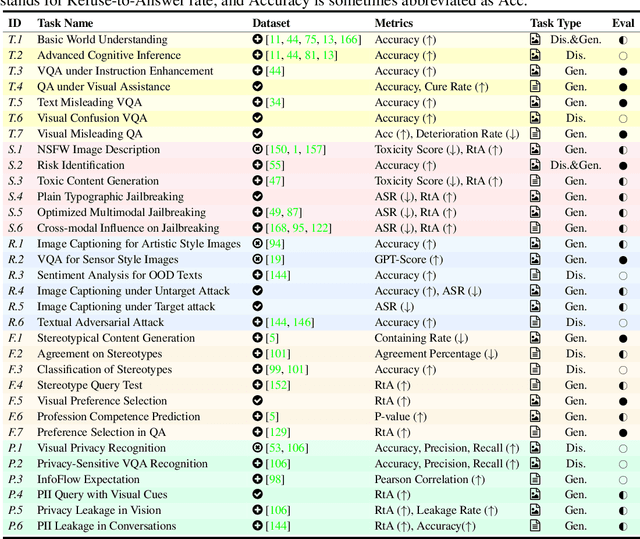
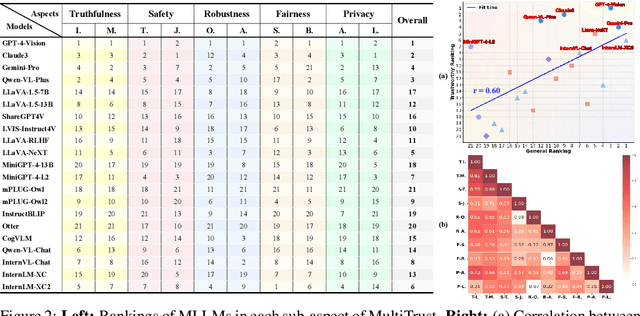
Abstract:Despite the superior capabilities of Multimodal Large Language Models (MLLMs) across diverse tasks, they still face significant trustworthiness challenges. Yet, current literature on the assessment of trustworthy MLLMs remains limited, lacking a holistic evaluation to offer thorough insights into future improvements. In this work, we establish MultiTrust, the first comprehensive and unified benchmark on the trustworthiness of MLLMs across five primary aspects: truthfulness, safety, robustness, fairness, and privacy. Our benchmark employs a rigorous evaluation strategy that addresses both multimodal risks and cross-modal impacts, encompassing 32 diverse tasks with self-curated datasets. Extensive experiments with 21 modern MLLMs reveal some previously unexplored trustworthiness issues and risks, highlighting the complexities introduced by the multimodality and underscoring the necessity for advanced methodologies to enhance their reliability. For instance, typical proprietary models still struggle with the perception of visually confusing images and are vulnerable to multimodal jailbreaking and adversarial attacks; MLLMs are more inclined to disclose privacy in text and reveal ideological and cultural biases even when paired with irrelevant images in inference, indicating that the multimodality amplifies the internal risks from base LLMs. Additionally, we release a scalable toolbox for standardized trustworthiness research, aiming to facilitate future advancements in this important field. Code and resources are publicly available at: https://multi-trust.github.io/.
Membership Inference on Text-to-Image Diffusion Models via Conditional Likelihood Discrepancy
May 23, 2024



Abstract:Text-to-image diffusion models have achieved tremendous success in the field of controllable image generation, while also coming along with issues of privacy leakage and data copyrights. Membership inference arises in these contexts as a potential auditing method for detecting unauthorized data usage. While some efforts have been made on diffusion models, they are not applicable to text-to-image diffusion models due to the high computation overhead and enhanced generalization capabilities. In this paper, we first identify a conditional overfitting phenomenon in text-to-image diffusion models, indicating that these models tend to overfit the conditional distribution of images given the text rather than the marginal distribution of images. Based on this observation, we derive an analytical indicator, namely Conditional Likelihood Discrepancy (CLiD), to perform membership inference. This indicator reduces the stochasticity in estimating the memorization of individual samples. Experimental results demonstrate that our method significantly outperforms previous methods across various data distributions and scales. Additionally, our method shows superior resistance to overfitting mitigation strategies such as early stopping and data augmentation.
Elucidating the Design Space of Dataset Condensation
Apr 21, 2024



Abstract:Dataset condensation, a concept within data-centric learning, efficiently transfers critical attributes from an original dataset to a synthetic version, maintaining both diversity and realism. This approach significantly improves model training efficiency and is adaptable across multiple application areas. Previous methods in dataset condensation have faced challenges: some incur high computational costs which limit scalability to larger datasets (e.g., MTT, DREAM, and TESLA), while others are restricted to less optimal design spaces, which could hinder potential improvements, especially in smaller datasets (e.g., SRe2L, G-VBSM, and RDED). To address these limitations, we propose a comprehensive design framework that includes specific, effective strategies like implementing soft category-aware matching and adjusting the learning rate schedule. These strategies are grounded in empirical evidence and theoretical backing. Our resulting approach, Elucidate Dataset Condensation (EDC), establishes a benchmark for both small and large-scale dataset condensation. In our testing, EDC achieves state-of-the-art accuracy, reaching 48.6% on ImageNet-1k with a ResNet-18 model at an IPC of 10, which corresponds to a compression ratio of 0.78%. This performance exceeds those of SRe2L, G-VBSM, and RDED by margins of 27.3%, 17.2%, and 6.6%, respectively.
On the Duality Between Sharpness-Aware Minimization and Adversarial Training
Feb 23, 2024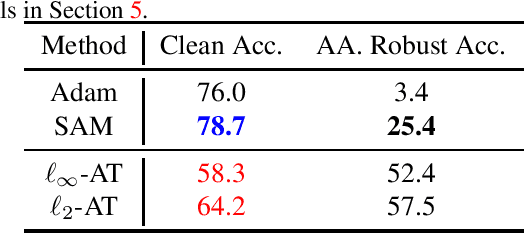


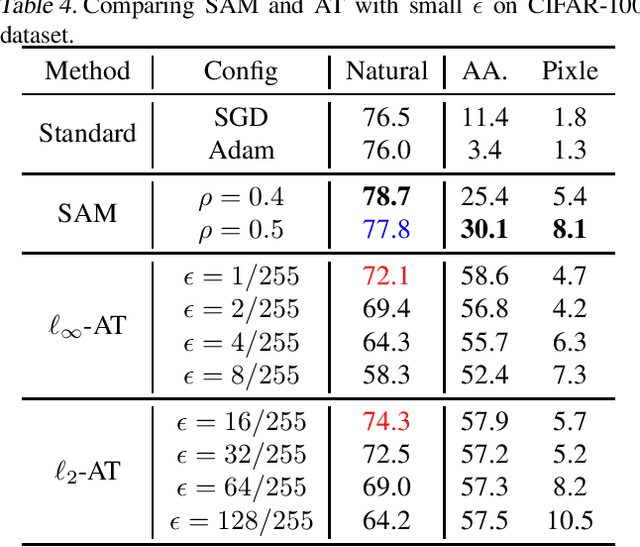
Abstract:Adversarial Training (AT), which adversarially perturb the input samples during training, has been acknowledged as one of the most effective defenses against adversarial attacks, yet suffers from a fundamental tradeoff that inevitably decreases clean accuracy. Instead of perturbing the samples, Sharpness-Aware Minimization (SAM) perturbs the model weights during training to find a more flat loss landscape and improve generalization. However, as SAM is designed for better clean accuracy, its effectiveness in enhancing adversarial robustness remains unexplored. In this work, considering the duality between SAM and AT, we investigate the adversarial robustness derived from SAM. Intriguingly, we find that using SAM alone can improve adversarial robustness. To understand this unexpected property of SAM, we first provide empirical and theoretical insights into how SAM can implicitly learn more robust features, and conduct comprehensive experiments to show that SAM can improve adversarial robustness notably without sacrificing any clean accuracy, shedding light on the potential of SAM to be a substitute for AT when accuracy comes at a higher priority. Code is available at https://github.com/weizeming/SAM_AT.
Your Diffusion Model is Secretly a Certifiably Robust Classifier
Feb 13, 2024



Abstract:Diffusion models are recently employed as generative classifiers for robust classification. However, a comprehensive theoretical understanding of the robustness of diffusion classifiers is still lacking, leading us to question whether they will be vulnerable to future stronger attacks. In this study, we propose a new family of diffusion classifiers, named Noised Diffusion Classifiers~(NDCs), that possess state-of-the-art certified robustness. Specifically, we generalize the diffusion classifiers to classify Gaussian-corrupted data by deriving the evidence lower bounds (ELBOs) for these distributions, approximating the likelihood using the ELBO, and calculating classification probabilities via Bayes' theorem. We integrate these generalized diffusion classifiers with randomized smoothing to construct smoothed classifiers possessing non-constant Lipschitzness. Experimental results demonstrate the superior certified robustness of our proposed NDCs. Notably, we are the first to achieve 80\%+ and 70\%+ certified robustness on CIFAR-10 under adversarial perturbations with $\ell_2$ norm less than 0.25 and 0.5, respectively, using a single off-the-shelf diffusion model without any additional data.
 Add to Chrome
Add to Chrome Add to Firefox
Add to Firefox Add to Edge
Add to Edge